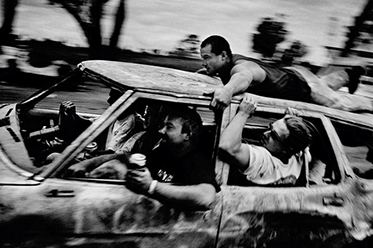 As Australia’s only member of Magnum, Trent Parke would be conscious of that celebrated post-war photo agency’s humanist legacy, and the critique of that legacy.
As Australia’s only member of Magnum, Trent Parke would be conscious of that celebrated post-war photo agency’s humanist legacy, and the critique of that legacy.
Put simply, humanism in photography refers to the use of photographs to represent the “human spirit” or “human experience”. That notion – which gained traction in the early to mid 20th century through the works of photographers such as Eugene Smith and Robert Doisneau – began to fall out of favour in the 1970s.
By capturing human experience, humanist photographs were said to rise above their actual content to represent larger values or ethics. But such myths obscured the agendas at work in the making, publication and exhibition of photographs.
There is a danger when the people depicted in photographs come to stand in for larger moral values. Just think of the work of Henri Cartier-Bresson or Dorothea Lange. What – or rather, who – is actually being promoted in works such as Lange’s iconic Migrant Mother (1936).
The photographer, and by extension his or her subjective vision, gains the praise, while the people depicted – the subjects – are rendered mute. We have human experience without any of the human context necessary to create understanding.
Although Parke’s photographs do not fit readily within a conventional humanist mode, his current exhibition at the Monash Gallery of Art – Trent Parke: the Camera is God – raises important questions about whether humanism is desirable or even possible in photography today.
Parke’s exhibition foregrounds the dual possibilities of photography that underpin the humanist tradition: to document the world and to reflect a subjective vision of that world. But here the two elements do not sit comfortably together.
Much of the exhibition centres on his impressive “the camera is god (street portrait series)” from 2013. To make those photographs, Parke set up his tripod on a corner of King Street, Adelaide, during evening rush hour on sunny days for almost a year.
By holding down his camera’s shutter-release as the traffic lights changed, Parke allowed his camera to take around 30 frames of the moving pedestrians in quick succession.
In the resultant grainy and blurred photographs, the facial features of the pedestrians are reduced to generalised shadowy contrasts – it’s as if a translucent veil or shroud has been placed over their faces. When assembled in an immense grid of 66 large individual portraits, these enigmatic faces become part of a bigger story.
This is a comment on the transience of the street and the dual sense of familiarity and anonymity – of physical proximity and personal distance – that we experience when looking at others in the city.
In one sense, Parke is following an earlier generation of documentary photographers and photojournalists who responded to critiques of photography’s objectivity by investing their work with an overt sense of personal subjectivity and narrative. In the 1980s, documentary photography made a new home in the art world. Yet his provocative title – the camera is god – is a simultaneous step back from his role as a photographer, artist and storyteller.
Inspired by Parke’s use of the shutter-release hold, the exhibition’s title is immensely loaded. It alludes to the 19th-century faith in the camera’s mechanical vision as superior to human vision, as well as the all-seeing, all-knowing eye of contemporary unmanned surveillance systems.
Parke may have let the camera’s automatic processes do the shooting, but the close cropping of his photographs, their development, printing, and installation all affirm that this series is the product of a human hand and mind. The result is that Parke, as photographer, is both present and elusive in this series – much like the faces in his street portraits.
The exhibition also includes work from an earlier series, Minutes to Midnight, mostly made between 2003 and 2005, during a time of heightened paranoia after the 911 terror attacks in the US. It’s part documentary, part open-ended fiction.
Parke travelled with his photographer wife Narelle Autio over almost 90,000 kilometres of Australia to picture an atmosphere of tension and uncertainty. Dark broody skies, a wild-eyed hunting dog clutching its prize, a landscape blasted by bush fires, and hoons hanging out of a racing car at Bathurst come together to create a sense of menace and unspoken threat.
It is no coincidence that this type of uneasy, unsettled documentary-as-art photography has gained traction today. The delivery of information and images has developed incredible pace, pushed along by the ever-present citizen photojournalist.
Meanwhile, the ideals of humanist documentary photography have fallen out of favour. Parke’s exhibition suggests that documentary photographers can nonetheless continue to raise deeper critical questions about the world around us.
Trent Parke: the camera is god is at the Monash Gallery of Art, Melbourne, until 12 February 2016. Details here.
The camera is god: photographer Trent Parke grapples with an impossible humanism
Melissa Miles, Associate Professor of Art History and Theory, Monash University
This article was originally published on The Conversation. Read the original article.
Image: Trent Parke, Bathurst races, NSW 1999, from the series Minutes to Midnight, gelatine silver print. Monash Gallery of Art, City of Monash Collection.
